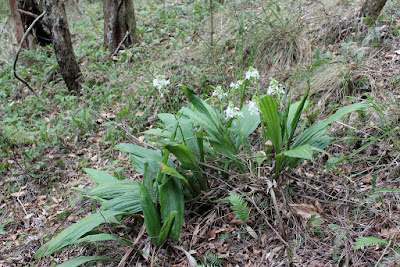Calanthe triplicata is native to Oceania, Asia, and the islands of eastern Africa. It grows in clumps in broad-leafed, humid, primary forests in crevasses in karst limestone with rich humus soil in humid, shady conditions at elevations of 500 to 1500 meters.
Calanthe triplicata also called as The Thrice Folded Calanthe, The Christmas Orchid, Alismorkis angraeciflora, Alismorkis diploxiphion, Alismorkis furcata, Alismorkis gracillima, Alismorkis veratrifolia, Amblyglottis veratrifolia, Bletia quadrifida, Calanthe anchorifera, Calanthe angraeciflora, Calanthe anthropophora, Calanthe australasica, Calanthe bracteosa, Calanthe brevicolumna, Calanthe breviflos, Calanthe catilligera, Calanthe colorans, Calanthe comosa, Calanthe diploxiphion, Calanthe furcata, Calanthe furcata f. albolineata, Calanthe furcata f. albomarginata, Calanthe furcata f. brevicolumna, Calanthe gracillima, Calanthe matsamurana, Calanthe nephroglossa, Calanthe orthocentron, Calanthe perrottetii, Calanthe petri, Calanthe proboscidea, Calanthe pubescens, Calanthe rubicallosa, Calanthe triantherifera, Calanthe triplicata f. albomarginata, Calanthe triplicata f. purpureoflora, Calanthe triplicata var. angraeciflora, Calanthe triplicata var. gracillima, Calanthe triplicata var minahassae, Calanthe undulata, Calanthe veratrifolia, Calanthe veratrifolia var. australis, Calanthe veratrifolia var denisimma, Calanthe veratrifolia var dupliciloba, Calanthe veratrifolia var incurvicalca, Calanthe veratrifolia var. kennyi, Calanthe veratrifolia var lancipetala, Calanthe veratrifolia var. stenochila, Calanthe veratrifolia var timorensis, Flos triplicata, Limodorum ventricosum, Limodorum veratrifolium, Orchis triplicata, Paracalanthe megalophora, is a species of the genus Calanthe. This species was described by Oakes Ames in 1907.
IDENTIFY CALANTHE TRIPLICATA ORCHID PLANT
Calanthe triplicata is native to Oceania, Asia, and the islands of eastern Africa. It grows in clumps in broad-leafed, humid, primary forests in crevasses in karst limestone with rich humus soil in humid, shady conditions at elevations of 500 to 1500 meters.
The Thrice Folded Calanthe is a medium to giant sized, warm to cool growing terrestrial with ovoid pseudobulbs carrying 3 to 6, up to 50 cm long and 15 cm wide, ovate-lanceolate, to elliptic-lanceolate, plicate, prominently ribbed, long petiolate leaves that are pubescent beneath.
The Christmas Orchid blooms from a mature pseudobulb as a new one arises in the spring through fall on a minutely pubescent, 210 cm long, racemose inflorescence with successive opening flowers that are congested at the apex and much longer than the leaves. The flowers look like flying white cranes and can also be pink in color. Petals and sepals are narrow and nearly equal in size, while the lip is several lobed, marked by a yellow or reddish vertical, linear wart-like callus. The characteristic features of Calanthe is the union of the column with the lip. The flowers last 3-4 weeks.
CALANTHE TRIPLICATA ORCHID PLANT CARE AND CULTURE
Cultural information should only be used as a guide, and should be to be adapted to suit you. Your physical location; where you grow your plants, how much time you have to devote to their care, and many other factors, will need to be taken into account. Only then can you decide on the cultural methods that best suit you and your plants.
Light:
Calanthe triplicata can withstand direct sun but prefers shade. Place it where will receive filtered sunlight only until mid-morning, remaining in full shade for the rest of the day.
Temperature:
In the active growth period The Thrice Folded Calanthe need the temperature of 15-27°C. For the rest period the temperature of 10-21°C is recommended.
Humidity:
The Christmas Orchid need the humidity level of 60-80%. Good ventilation is strongly recommended to avoid rot due to high moisture levels required.
Substrate, growing media and repotting:
Calanthe triplicata is usually grown in pot with peat moss and treated hardwood sawdust as substrate. It can also be grown in hanging basket as accent or border plant. Repotting is done every 2-3 years. When repotting Calanthe triplicata, the pseudobulbs must be half buried into the potting media.
Watering:
This species is plentiful watering, especially during the summer months. After flowering is finished, give them only enough water to keep the potting mixture from drying out completely. This orchid can become deciduous; if water is reduced in the autumn and the plant is kept cool the leaves may drop. It will resprout in the spring. If the temperature is a bit warmer and it retains the leaves, keep it slightly moist through the winter.
Fertilizer:
The Thrice Folded Calanthe need regular and generous feeding, thriving on a rich compost and application of liquid fertiliser about once every two weeks during the growing season.
Rest period:
Calanthe triplicata doesn't need a rest period. The growing conditions should be maintained throughout the year. Watering can be reduced slightly in winter, especially if the plant is grown in latitudes where there is less light and shorter days. However, these plants should never be dried out. When limiting watering in winter, fertilization should also be reduced, returning to increased watering and fertilizing in spring.















COMMENTS